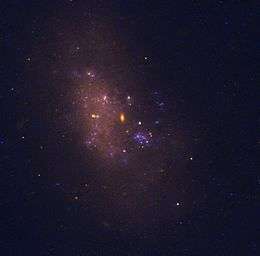NGC 14
NGC 14 is an irregular galaxy in the Pegasus constellation. It was included in Halton Arp's Atlas of Peculiar Galaxies, under the section "Galaxies with the appearance of fission," since the irregular appearance of this galaxy causes it to look like it is separating apart.[4] It was discovered on September the 18th 1786 by William Herschel.[5]
| NGC 14 | |
|---|---|
 NGC 14 | |
| Observation data (J 2000.0 epoch) | |
| Constellation | Pegasus |
| Right ascension | 00h 08m 46.4s |
| Declination | +15° 48′ 59″ |
| Redshift | 0.002885[1] |
| Helio radial velocity | 865 ± 1 km/s[1] |
| Distance | 47.1 Mly (12.8 Mpc)[2] |
| Apparent magnitude (V) | 12.71[1] |
| Absolute magnitude (V) | -17.24 [3] |
| Characteristics | |
| Type | (R)IB(s)m pec[1] |
| Apparent size (V) | 1.995′ × 1.349′[1] |
| Other designations | |
| UGC 75, PGC 647, Arp 235[1] | |
References
- "NASA/IPAC Extragalactic Database". Results for NGC 0014. Retrieved 2010-05-03.
- "Distance Results for NGC 0014". NASA/IPAC Extragalactic Database. Retrieved 2010-05-03.
- https://in-the-sky.org/data/object.php?id=NGC14b
- Arp, Halton (1966). Atlas of Peculiar Galaxies. Pasadena, California: California Institute of Technology. Retrieved 5 Jan 2010. (webpage includes PDF link)
- Seligman, Courtney. "NGC 14". Celestial Atlas. Retrieved 7 November 2018.
External links

- NGC 14 on WikiSky: DSS2, SDSS, GALEX, IRAS, Hydrogen α, X-Ray, Astrophoto, Sky Map, Articles and images
This article is issued from Wikipedia. The text is licensed under Creative Commons - Attribution - Sharealike. Additional terms may apply for the media files.